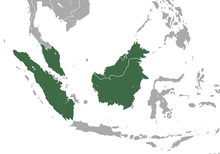
Megabats constitute the family Pteropodidae of the order Chiroptera (bats). They are also called fruit bats, Old World fruit bats, or—especially the genera Acerodon and Pteropus—flying foxes. They are the only member of the superfamily Pteropodoidea, which is one of two superfamilies in the suborder Yinpterochiroptera. Internal divisions of Pteropodidae have varied since subfamilies were first proposed in 1917. From three subfamilies in the 1917 classification, six are now recognized, along with various tribes. As of 2018, 197 species of megabat had been described.

The Mariana fruit bat, also known as the Mariana flying fox, and the fanihi in Chamorro, is a megabat found only in the Mariana Islands and Ulithi. Habitat loss has driven it to endangered status, and it is listed as threatened by the US Fish and Wildlife Service. Poachers and food hunters, other animals, and natural causes have led to the decline.

The Egyptian fruit bat or Egyptian rousette is a species of megabat that is found in Africa, the Middle East, the Mediterranean, and the Indian subcontinent. It is one of three Rousettus species with an African-Malagasy range, though the only species of its genus found on continental Africa. The common ancestor of the three species colonized the region in the late Pliocene or early Pleistocene. The species is traditionally divided into six subspecies. It is considered a medium-sized megabat, with adults weighing 80–170 g (2.8–6.0 oz) and possessing wingspans of approximately 60 cm (24 in). Individuals are dark brown or grayish brown, with their undersides paler than their backs.

The dayak fruit bat or dyak fruit bat is a relatively rare frugivorous megabat species found only on the Sunda Shelf of southeast Asia, specifically the Malay Peninsula south of the Isthmus of Kra, and the islands of Borneo and Sumatra. There are three species in the genus Dyacopterus: D. spadiceus, D. brooksi and D. rickarti. All are found in the forests of Malaysia, Thailand, and the Philippines. Few specimens of any of the three species exist, due not only to their rarity, but also because they rarely enter the sub-canopy of the forest where they can be caught in scientists' nets.

The pygmy fruit-eating bat is a bat of the family Phyllostomidae. The specific name phaeotis is of Greek derivation, coming from the word phaios meaning dusky, referring to their dusky gray coloration.

The dwarf little fruit bat is a species of leaf-nosed bat from South America.

The Mauritian flying fox, also known as Greater Mascarene flying fox or Mauritius fruit bat is a large megabat species endemic to Mauritius and La Réunion.
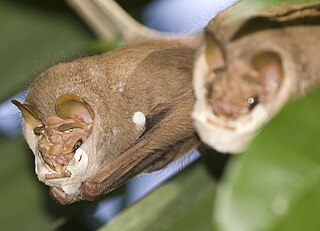
The wrinkle-faced bat is a species of bat in the family Phyllostomidae and the only identified member of the genus Centurio. This bat is found in various countries in and around Central America. It eats fruit but is not classified within the fruit bats, and is instead classified as a leaf-nosed bat even though it does not have a leaf nose. It has an unusually shaped skull which is thought to allow it to eat a wider range of foods than other bats.

The greater short-nosed fruit bat, or short-nosed Indian fruit bat, is a species of megabat in the family Pteropodidae found in South and Southeast Asia.

The Madagascan fruit bat is a species of bat in the family Pteropodidae. It is endemic to Madagascar and is listed as "Vulnerable" by the IUCN because it is hunted as bushmeat.

The straw-coloured fruit bat is a large fruit bat that is the most widely distributed of all the African megabats. It is quite common throughout its area ranging from the southwestern Arabian Peninsula, across forest and savanna zones of sub-Saharan Africa. It is listed as Near Threatened on the IUCN Red List due to a decreasing population trend. Straw-coloured fruit bats travel in massive colonies of at least 100,000 bats and sometimes massing up to 1 million. From October to end of December every year, in the largest migration of mammals on the planet, up to 10 million straw-coloured fruit bats congregate in Kasanka National Park, Zambia, roosting in a 2 hectare area of Mushitu forest each day. This migration was only discovered in 1980. Their necks and backs are a yellowish-brown colour, while their undersides are tawny olive or brownish.
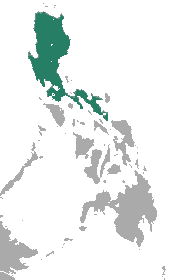
The Luzon fruit bat is a species of megabat in the family Pteropodidae. It is the only species within the genus Otopteropus and is endemic to the Philippines. Its natural habitat is subtropical or tropical dry forest.
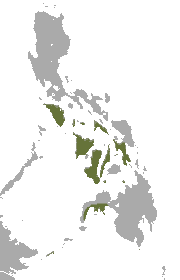
The little golden-mantled flying fox is a species of bat in the family Pteropodidae. It is found in Indonesia and the Philippines. Its natural habitat is subtropical or tropical dry forests.

The Madagascan flying fox, Madagascar flying-fox, or Madagascar fruit bat is a species of megabat in the genus Pteropus. It is endemic to Madagascar. Its natural habitats are diverse, and include moist lowland forests, dry forests, succulent woodlands, and spiny thickets, and mangroves. It eats figs and other fruits, flowers, and leaves. It is threatened by habitat loss.

The Pemba flying fox is a species of flying fox in the family Pteropodidae. It is endemic to the island of Pemba on the coast of Tanzania.

The Sulawesi rousette or Sulawesi fruit bat is a species of megabat in the family Pteropodidae endemic to Sulawesi, an island in Indonesia. It is presently the only member of the genus Pilonycteris.
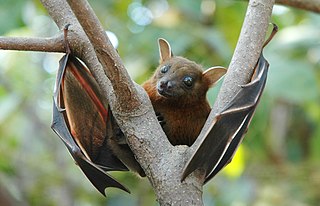
The lesser short-nosed fruit bat is a species of megabat within the family Pteropodidae. It is a small bat that lives in South Asia and Southeast Asia. It weighs between 21 and 32 grams, and measures 70 to 127 millimetres. It occurs in many types of habitat, but most frequently in disturbed forest, including lower montane forest and tropical lowland rain forest, plus gardens, mangroves, and vegetation on beaches.

